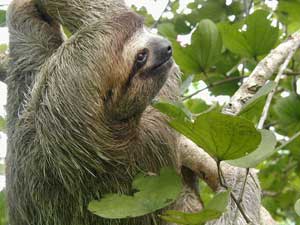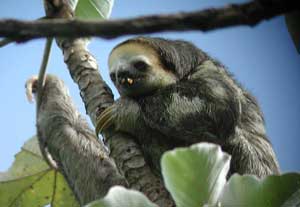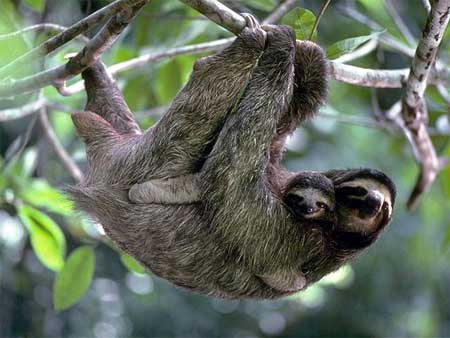In the animal kingdom, the Bradypus tridactylus, commonly known as the sloth, is perhaps the largest and laziest of all mammals, earning it the rather unflattering name: “The Lazy One.” Few animals move as slowly as the sloth, which is famously “slower than a turtle.” The maximum speed of these creatures is astonishingly low: over the course of an entire day, they move less than 30 meters.
 |
|
(Photo: tropicalhardwoods) |
The Bradypus tridactylus primarily feeds on the leaves, fruits, and young branches of the Cecropia lyratiloba tree. They forage for food in a rather blind manner: relying on smell and touch due to their underdeveloped sight and hearing, they cannot locate food as other animals typically do.
Watching them eat can be quite frustrating: they slowly pull in and consume whatever is within reach of their mouths, at an extremely sluggish pace. This is the external behavior, but internally: their bodies digest food at an equally slow rate—taking about a month to fully digest a stomach full of food. Because of this eating habit, the “King of Laziness” has had to adapt: their bodies are always striving to absorb as many nutrients as possible from their food. Moreover, the stomach of the “King of Laziness” is large enough to hold an amount of food equivalent to one-third of its body weight. That’s quite a substantial amount of food.
The sloth also has a unique tree-dwelling lifestyle: they can hang motionless for many hours. In this position, they resemble tree branches, which helps them camouflage from predators. Typically, they hang from trees, and when eating, they lie on their backs with their bellies facing the sky; they even sleep in this position and give birth while hanging upside down, with their backs facing the ground. They live almost their entire lives in this “upside-down” manner.
While they may seem easy prey for predators, the “Kings of Laziness” have several defensive strategies: each finger and toe has a long, curved claw capable of inflicting deep wounds. A swipe from these sharp claws can deter a predator. Generally, these claws, shaped like hooks, help them hang, move, and “pose like statues” in the trees. They are excellent at camouflage, particularly during the rainy season when green algae grow in their fur. Their long, thick coats have gaps that allow green algae to grow, giving them a slightly greenish appearance. Their tendency to remain motionless makes them look like broken branches. Only a truly “elite” lazy creature can achieve such a green, mossy coat.
For almost their entire lives, these remarkable animals live in trees, but occasionally they do come down to the ground.
Once a week, the sloth descends to the ground to defecate in a hole they dig with their tails. These animals also “practice good manners” and “maintain hygiene,” even though going to the ground is quite dangerous for them.
 |
| (Photo: u-blog) |
When on the ground, they can only lie on their backs or on their stomachs, moving awkwardly by dragging themselves along with their limbs and claws. As a result, when they are on the ground, they are easy prey for jaguars and many other predators.
Despite their extremely slow climbing, moving limb by limb, and their clumsiness on the ground, surprisingly, these lazy creatures can swim effortlessly in water. The “King of Laziness” can submerge themselves in water better than any terrestrial animal.
They also have another unusual characteristic: their necks are particularly flexible, allowing them to turn their heads back and forth. Sloths have two more cervical vertebrae than other mammals, enabling them to rotate their heads smoothly through a range of 270 degrees (a sloth has nine cervical vertebrae, while most mammals only have seven).
The sloth sleeps throughout the day, often resting its head between its front limbs. They are nocturnal and typically live alone, ready to fend off other sloths of the same sex that intrude on their territory.
The mating season occurs from March to April. After a gestation period of 120 to 180 days, females give birth to a single offspring. They give birth while hanging from a tree. At birth, the baby sloth clings to its mother’s fur and remains in her embrace until it is five weeks old, at which point it can cling to tree trunks and forage on its own. The young sloth suckles for about a month and then is fed with pre-chewed food by its mother. The young sloth stays close to its mother until it is six months old.
In terms of appearance: they have a round head on a long, flexible neck. Their eyes and ears are tiny compared to their large bodies. Their fur is thick and shaggy, brown-gray in color, with white and yellow spots on their backs. Their limbs are long, with the front limbs longer than the hind limbs. The palms and soles of their feet are also hairy. An adult sloth’s body length is approximately 55 cm, with a tail length of about 7 cm, and they weigh around 4.5 kg. They are usually silent but can produce some whimpering sounds.
Sloths are distributed across Central and South America in forested areas and along riverbanks where the Cecropia lyratiloba tree grows.

(Photo: hedweb)





















































